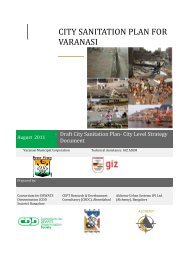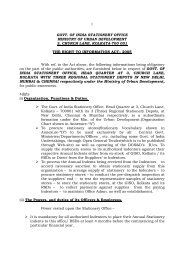CITY SANITATION PLAN - Ministry of Urban Development
CITY SANITATION PLAN - Ministry of Urban Development
CITY SANITATION PLAN - Ministry of Urban Development
Create successful ePaper yourself
Turn your PDF publications into a flip-book with our unique Google optimized e-Paper software.
<strong>CITY</strong> <strong>SANITATION</strong> <strong>PLAN</strong> BAREILLY<br />
about 3500 – 5000 (in Rs) per annum. But, the amount that is being allocated is not separately for<br />
school toilets maintenance. It is the overall school maintenance budget allocation for the entire year,<br />
which is hardly sufficient for any kind <strong>of</strong> developments or improvements <strong>of</strong> toilet facilities in these<br />
schools.<br />
Based on the above mentioned budget allocation and responsible agents for O&M, there are about<br />
85% <strong>of</strong> the schools who made few improvements to the toilets during the last 3 years. And the<br />
improvements are only related to minimal – such as fixing up the doors, fixing up the water<br />
connection, painting <strong>of</strong> walls and doors, flooring, and cleaning at regular intervals. Thus, this also<br />
show that majority <strong>of</strong> schools with toilets have further improvements to avoid further damage. In<br />
addition to toilet cleaning status, it is also important to consider the cleaning activities for the water<br />
storage facilities and the school premises. The analysis shows that about 58% <strong>of</strong> the schools have<br />
their cleaning activities done for storage facilities for every 6 months and about 32% <strong>of</strong> them<br />
annually. There are about 10% <strong>of</strong> schools who do not have any kind <strong>of</strong> cleaning activities in schools<br />
and its infrastructure.<br />
In addition to this, solid waste disposal is also important to consider. The waste generated at school<br />
premises can be disposed and it is being categorized into road side bins, open site disposals, into<br />
drains and door to door collection. The analysis shows that about 64% <strong>of</strong> the schools dispose their<br />
waste into road side bins; and about 13% on open sites and the rest through regular door to door<br />
collection. Thus, it can be concluded that the solid waste disposal mechanism at schools is safe. In<br />
addition to this, the all the schools in Bareilly has a curriculum which provides basic sanitary and<br />
hygiene education to the students which reflects upon proper usage and maintenance <strong>of</strong> the toilets<br />
at schools by students.<br />
Key Issues:<br />
1. About 40% <strong>of</strong> the schools do not have any workers to maintain the cleanliness <strong>of</strong> the<br />
surroundings <strong>of</strong> the school<br />
2. About 47% <strong>of</strong> the schools whose toilets are not in any working conditions.<br />
3. About 30% <strong>of</strong> the school’s cleanliness is done by students themselves<br />
ADMINISTRATIVE STAFF COLLEGE OF INDIA, HYDERABAD Page 113
















